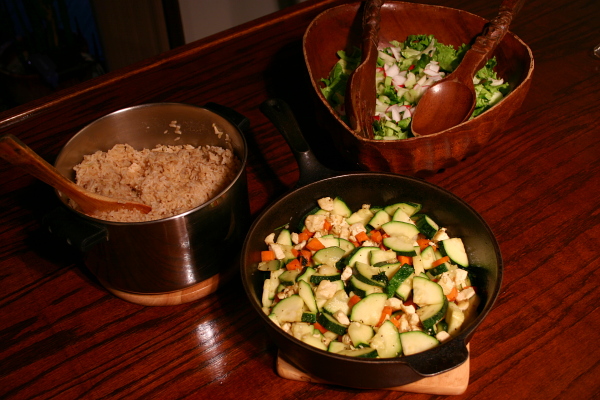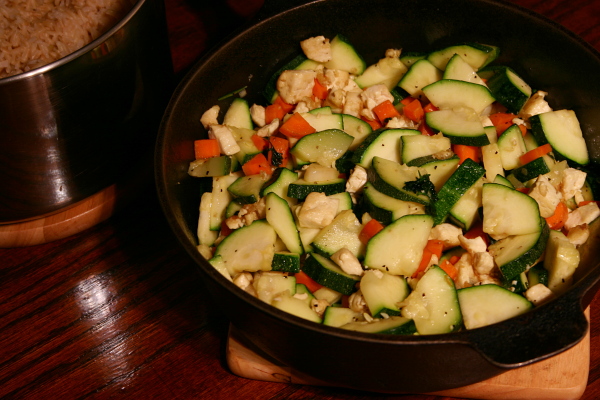

p i c t u r e d : brown basmati rice, a big fresh homegrown salad, and cooked carrots, tofu, homegrown zucchini and parsley
to get the greatest nutritional / energy impact out of cereal grains, vegetables and fruit, and beans/legumes, they should be prepared and proportionally combined in a way that each compliments and enhances the other... this is relatively simple, in that all you are doing most of the time is having some kind of grain, with some kind of bean, and some kind of veggie... each of these alone is not quite complete, but put together they will provide balanced whole food nutrition that sustains radiant health
drawing from the wisdom of all cultures and ages gives us a wide variety of food combinations to choose from - it NEVER gets boring when you incorporate the tastes and techniques of the whole world! everything is based on this same basic trinity - grain, vegetable / roots / tubers, bean / legume / nuts and seeds... herbs, condiments, and other semi-refined foods which we add are still all derived from or related to these basic elements
the standard macrobiotic diet is: 50% whole cereal grains, 20-30% vegetables, 5-10% soups - etc., 5-10% beans - sea vegetables - etc., with occassional use of local fruit in season, nuts, seeds, sweet stuff, and snacks... we have used a synthesis of classic vegan / vegetarian, macrobiotic, ayurvedic, and raw-foods diets for over 30 years, and perfect health has always been the result
italian: organic pasta, tofu veggie-balls, fresh salad...indian: organic rice, curried vegetables with tofu,
fresh salad... japanese: organic rice, adzuki beans, miso soup, fresh salad... north american: corn bread, black eyed peas, collard greens, fresh salad... mexican: whole grain tortillas, refried beans, mixed vegetables like tomato, pepper, olive, lettuce... chinese: mung bean and vegetable stir fry with rice... middle-eastern: pita bread sandwiches with hummus and veggies or tofu salad and veggies... these are just a few super-basic examples of how extensive the variety can really be when you incorporate many ingredients, techniques, and tastes
Food Combining Guidelines
- Fruit and vegetables should not be taken at the same meal. The use of both produces acidity of the stomach and often causes distress. It is best to have fruit at one meal; and vegetables at another.
- Avoid combining too many different kinds (classes) of food at the same meal. Two or three different kinds (classes) are best.
EXPLANATION: You may have a salad with 4 or 5 different kinds of leafy greens BUT they are all in the same class. You may also have at that meal a protein dish made of legumes; and you may include some olives and avocados.
In this meal you would have several different kinds of food, BUT only 3 classes (1. Leafy vegetables; 2. Legumes; and 3. Neutral foods.)
- Do not have too great a variety at a meal. Three or four dishes are plenty. These dishes should be made of the classes of foods that combine well and are compatible with each other. The more simple the meals - the better.
- Avoid beans and potatoes at the same meal. One is a heavy protein - the other a heavy starch. Proteins require an acid medium in digestion, while CARBOHYDRATES need the alkaline saliva of the mouth and alkaline juices of the intestines to complete digestion. PROTEINS activate pepsin of the stomach, needed to split the protein molecule, and bring forth hydryochloric acid for complete protein digestion. When the acids and alkalines are brought together, neutralization may result, and neither of the foods are easily or properly digested. This results in gas, fermentation of the carbohydrates, and undigested acid end products from the proteins. In time this will lower the vitality of the body. (Do not mix heavy starches and heavy proteins at the same meal.)
- Avoid serving more than two foods rich in protein of carbohydrates (sugars and starches) at the same meal. Choose carbohydrates that are in their natural state - such as whole grain bread and natural sweet fruits. Omit refined carbohydrates such as white flour products and refined sugars. Choose proteins of vegetable sources such as legumes. These are adequate combined with grains and nuts.
- Avoid the use of grease in foods. Use the natural oils from olives, seeds, nuts and legumes (such as soybean oil.) Oil is NOT grease. Lard, butter and vegetable oils made hard are grease. Ask any service man to tell you the difference between grease and oil.
- Replace flesh foods with an abundance of nourishing grains, fruits, vegetables and nuts. The grains combined with fruits, nuts and vegetables, contain all the nutritive properties necessary to make good blood and healthy bodies.
- "Milk and sugar clog the system, irritate the digestive organs , and affect the brain... Sugars and milk combined are liable to cause fermentation in the stomach." EXPLANATION: High sugar levels in the brain is not best. When refined sugars are taken into the system, a more rapid rise in blood sugar is noticed. This does not happen with the more natural sweets (raw honey, dates). The more natural sweets have a high mineral and enzyme content, whereas refined sugars are void of everything but the sweetening agent. Because of the minerals and enzymes in natural sweets, they are good for food and energy, whereas the refined sweets are good for NOTHING. They will actually take away from the body and deplete the system.
The combination of vegetable milks (nut, see, soy) and honey or date sugar (dates) is perfectly all right. BUT the combination of cows milk and sugar (especially refined white sugar) is injurious because it has a very rapid action with the bacteria in the milk to cause fermentation. The more natural sweets (honey, molasses, dates, etc.) with cows milk, still causes fermentation but on a much lesser scale because of the presence of enzymes and mierals which assist in digestion. Therefore it would be better to use the latter (natural sweets) with the dairy products, preparatory to excluding cows milk and sugar from the diet completely.
A simple test to proove the difference between natural and refined sugars: take two hungry people, as near alike as possible. Give one a pound of dates and the other a pound of candy. Just notice which one consumes the most and still wants more! The person who eats the dates usually has a hard time finishing the whole pound, because of natural gag-reflex which is his protection against over-eating. The person who eats the candy usually will finish the first pound and can still eat more, because no gag-reflex takes place when refined sugars are eaten. Over-eating is very common when refined sweets are added to the diet. On the contrary, it is almost impossible for one to become a glutton eating natural foods.
|
Guidlines of Eating
- Eating slowly, no drink is necessary with a meal, chew the food thoroughly so it will be well mixed with saliva. Digestion begins in the mouth. Learn to Fletcherize your food - which means - chew it so well that it swallows itself.
- Do not drink with the meals. Food should not be washed down. The more liquid there is taken into the stomach with the meals, the more difficult it is for the food to digest.
- Drink plenty of water on arising and between meals. Water is the best liquid possible to cleanse the tissues, and purify the blood. Try two glasses of hot water on arising - its easy to get down. Drink some a little time before meals.
- Eat sparingly "For strength and not for drunkenness!" The benefit you derive from your food, does not depend so much on the quantity eaten, as on its thorough digestion. Neither does gratification of taste depend so much on the amount of food swallowed, as on the length of time it remains in the mouth. Over-eating clogs the machinery and weakens the power to resist other passions.
- Eat at regular intervals, allowing between 5-6 hours to elapse between the meals. Do not eat a morsel between the meals. This is a bad habit to overcome once started. When hungry between meals, look at the clock. If it is not time to eat, take a big drink of life-giving cool water. (Hunger pangs after a full meal is probably a sign of indigestion.)
- Do not eat before going to bed. The stomach must not be constantly at work, but must have periods of rest. When you retire, the stomach should have its work all done so it may rest with you. If you feel that you must eat, take a drink of cold water, and in the morning you'll feel much better for having not eaten.
- Do not eat when emotionally upset or over-tired or in pain.
- Two meals a day are better than 3 but if a third meal be eaten at all, it should be light, and several hours before going to bed. Two meals at 8am and 3pm, three meals at 6am, 12pm, and 6pm.
- Foods that are too hot or too cold should not be eaten. Very hot soups and such foods tend to debilitate the stomach and are best partly cooled. Very cold foods require the vitality of the system to warm them until they are the same temperature as the stomach before the work of digestion can be carried on.
- Eat more raw fruits in their natural state. Include in the diet more raw fresh foods and less cooked food. At least half of the foods we eat should be raw. Avoid spending precious hours trying to "doctor up" foods that are more wholesome in their natural raw state.
- Eat raw vegetable salads and raw fruits before the main course. This will stimulate and assist digestion and help avoid over-eating of cooked foods. Even fruit should not be eaten after a full meal of other foods.
- It is not well to take a great variety of food at one meal. 3 or 4 dishes are plenty.
|
How To Chew
Many people do not know how to chew, even though chewing is basic to life. The standard bite is 80 grains placed in the mouth at one time. Try counting them once to see how much this is. It is a small volume. Vegetables can be an equivalent volume. After putting this amount of food in your mouth, put your chopsticks or utensils down and chew, not up and down, but around so that your teeth and tongue move in a circular, spiral pattern.
The ability to move the jaw in many different directions is unique to human beings; animals can chew in only one direction or another, but not in all of the possible ways, comprehensively. We must take advantage of this flexibility, as it is the source of our spirituality. When you chew this way, food becomes well-mixed with saliva and also completely crushed, even if your teeth are not good. Thorough chewing strengthens your digestive organs, increases the utilization of food, and makes your physical condition better. Chewing makes it possible to get by with less. In Japan, chewing is called Kamu, a verb with a sound that is similar to the noun for the word "God", which is pronounced Kami.
next recipe | previous recipe | index
